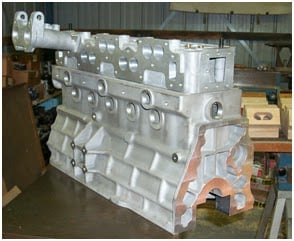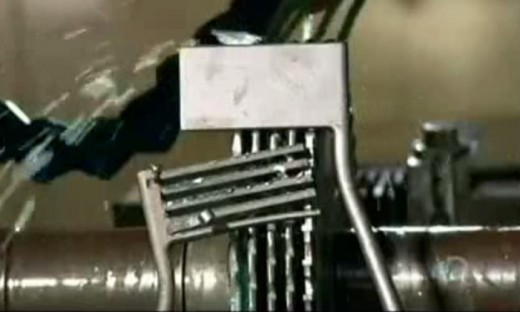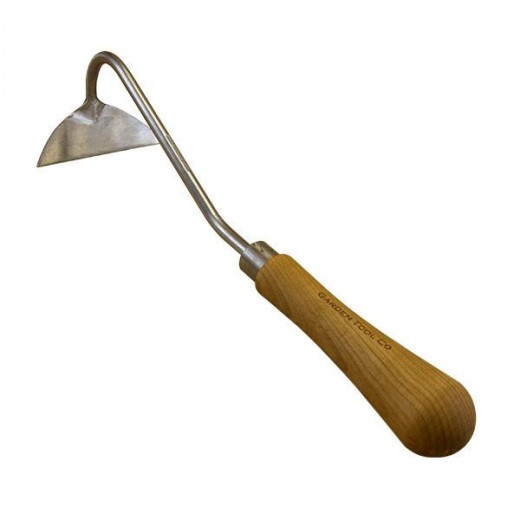
In
some universities and tertiary institutions that study engineering
courses, this department is referred to as just Metallurgical
engineering while some call it Metallurgical and Materials Engineering.
But in all, they are still referring to almost the same area of
engineering.
So, it is not wrong if you change this topic to the “Applications and Roles of Metallurgical Engineering”. This is one of the newest
branches of engineering derived from Mechanical Engineering. This aspect of engineering specializes in Metals coupled with semiconductors and non-metals (the materials aspect). But, its scope is largely on metallic materials.
According to Daniel H. Herring, it is the role of the materials engineer to study, develop, design and operate processes that transform raw materials into useful engineering products intended to improve the quality of our lives.
The metallurgical and materials engineering discipline is unique because it provides a focus for convergence of technologies. Its uniqueness naturally defines its role and dictates its increasing relevance in several disciplines and modern practices and techniques.
So, it is not wrong if you change this topic to the “Applications and Roles of Metallurgical Engineering”. This is one of the newest
branches of engineering derived from Mechanical Engineering. This aspect of engineering specializes in Metals coupled with semiconductors and non-metals (the materials aspect). But, its scope is largely on metallic materials.
According to Daniel H. Herring, it is the role of the materials engineer to study, develop, design and operate processes that transform raw materials into useful engineering products intended to improve the quality of our lives.
The metallurgical and materials engineering discipline is unique because it provides a focus for convergence of technologies. Its uniqueness naturally defines its role and dictates its increasing relevance in several disciplines and modern practices and techniques.
What is Metallurgical Engineering?
Metallurgical
engineering is the part of materials science and materials engineering
that studies the physical and chemical behavior of metallic elements,
their intermetallic compounds, and their alloys. Metallurgical
engineering studies the metals and in turn, determines where they can be
best applied for optimum result.
As one who specializes in the area of metallurgical and materials engineering, I have had experience in this discipline. I have worked with National Metallurgical Training Institute where I got exposed to many areas where materials engineering has its diverse applications. With these and many other experiences, I came up with the idea to put up articles and textbook on where this unique branch of engineering has its impacts. It is a powerful book that will make people who have good interest in the discipline go far in learning. The book is an eye opener and unique as it details out the areas where this discipline is applied and plays special roles.
As one who specializes in the area of metallurgical and materials engineering, I have had experience in this discipline. I have worked with National Metallurgical Training Institute where I got exposed to many areas where materials engineering has its diverse applications. With these and many other experiences, I came up with the idea to put up articles and textbook on where this unique branch of engineering has its impacts. It is a powerful book that will make people who have good interest in the discipline go far in learning. The book is an eye opener and unique as it details out the areas where this discipline is applied and plays special roles.
Automobile
Have
you ever seen a car which is not made of metals and materials? The two
major type of materials found in automobiles is plastics and metals. In
the modern day cars, the outer part is mainly plastics while some of the
major internal parts are made of metals which are mainly steel. Steel
is a great metal which has the highest metallic application all over the
world.
The areas in automobiles where plastics are used are but not limited to the transparent headlights and rear lights; summer and winter tires; safety belts; heat-resistant plastics close to the engine; and foams located in the car seats. Polymer is an important topic that cannot be done without before any graduate from the field is called a Materials Engineer. This is why the area is handled well as it is taught to the students during their undergraduate study. This makes them understand the kind of polymeric materials that can serve some purposes. A seatbelt, for instance, needs to be strong but flexible and the kind of plastic material used for its production to serve the expected purpose is polyethylene terephthalate. It takes a Materials Engineer to critically examine the constituents that give the product.
Also, steels are used in so many areas of an automobile. A typical example is an engine. The engines of cars are cast carefully. That is to say that the process through which car engines are produced is through the casting process. Before the casting of any kind is carried out, it is the duty of the metallurgical engineer to give the quotation of the metallic components to be used in the casting. He also ensures the strength of the cast engine is enough to withstand pressure and heat joined with other inspection processes before use in any car.
The areas in automobiles where plastics are used are but not limited to the transparent headlights and rear lights; summer and winter tires; safety belts; heat-resistant plastics close to the engine; and foams located in the car seats. Polymer is an important topic that cannot be done without before any graduate from the field is called a Materials Engineer. This is why the area is handled well as it is taught to the students during their undergraduate study. This makes them understand the kind of polymeric materials that can serve some purposes. A seatbelt, for instance, needs to be strong but flexible and the kind of plastic material used for its production to serve the expected purpose is polyethylene terephthalate. It takes a Materials Engineer to critically examine the constituents that give the product.
Also, steels are used in so many areas of an automobile. A typical example is an engine. The engines of cars are cast carefully. That is to say that the process through which car engines are produced is through the casting process. Before the casting of any kind is carried out, it is the duty of the metallurgical engineer to give the quotation of the metallic components to be used in the casting. He also ensures the strength of the cast engine is enough to withstand pressure and heat joined with other inspection processes before use in any car.

Medical/Health Sector
In
various hospitals all over the globe, we see the nurses make use of
syringes to inject drugs into the systems of the patients. This method
of treatment has been proven as one of the fastest means of treating
patients. When the doctors administer drugs, the nurses cannot be able
to get some of these drugs into the system of the sick ones without the
use of the syringe.
Medical surgical operations have proven one of the major ways of rescuing the lives of individuals and striking balance in human procreation. In the European Continent for example, many pregnant mothers prefer to give birth through surgery to direct delivery. Some are because fear and others due to the reason best known to then.
But in all these, the question that emerges as a result of the topic under discussion is, are these equipments being used during these operations manufactured by the doctors and the other medical practitioners? The simple answer is no. The doctors’ role is to use these equipments to perform their duties. Most of these equipments are manufactured by the mechanical, metallurgical and material engineers.
In the field of medicine and surgery, most of the retractors used are made of steel material. They are made in such a way that they shall meet the need of their productions. At the finishing stages of the production, they are coated with substances which cannot react with the body of the patients during operations. The material in the other words must be corrosion resistance.
The production starts with the heating of steel bar to high temperature. This temperature must be the state in which the bar must be susceptible to hammering process. The metallurgical process used for the production of retractors is through forging.
Medical surgical operations have proven one of the major ways of rescuing the lives of individuals and striking balance in human procreation. In the European Continent for example, many pregnant mothers prefer to give birth through surgery to direct delivery. Some are because fear and others due to the reason best known to then.
But in all these, the question that emerges as a result of the topic under discussion is, are these equipments being used during these operations manufactured by the doctors and the other medical practitioners? The simple answer is no. The doctors’ role is to use these equipments to perform their duties. Most of these equipments are manufactured by the mechanical, metallurgical and material engineers.
In the field of medicine and surgery, most of the retractors used are made of steel material. They are made in such a way that they shall meet the need of their productions. At the finishing stages of the production, they are coated with substances which cannot react with the body of the patients during operations. The material in the other words must be corrosion resistance.
The production starts with the heating of steel bar to high temperature. This temperature must be the state in which the bar must be susceptible to hammering process. The metallurgical process used for the production of retractors is through forging.
Retract Jaw

Aerospace
No
modern aircraft is complete without involving metallurgical and
materials engineers. For any aircraft to be constructed completely, some
things are put into considerations. One of the factors to be considered
is the weight of the entire product. And to construct any with less
weight, material engineers are called for proper and adequate materials
selections. They select materials with sound qualities and less weight.
Also, the strength of the materials is put into considerations as well.
In the components of the entire aircraft, most of the parts are made using metallurgical approach. Many of the parts are cast to the standard of the aerospace engineers. After these parts are cast, the inspection and other finishing processes are also carried out to ensure that there will be no failure in the use of the product in the long run.
Some parts of aircraft which are cast are the bolts, engine cylinder heads, helicopter transmission, auxiliary gearboxes, generator housings, canopies, an intermediate compressor for turbine engines. Forging is carried out by metallurgical engineers. There are many parts of aircraft that are produced by forging and among them are compressor blades and turbine disks.
Aircraft canopies are made of multi-layer of materials. This is because of the purpose they serve. F-16 aircraft are made of three layers. The innermost part is made of polycarbonate. The middle is made of polyurethane. The polyurethane bonds the inner to the outer layer. The outer layer on the other hand is made of acrylic (PMMA).
Strength testing of the individual parts of aircraft is very important. Depending on the part, compressive, flexural, or tensile test is carried out. These tests builds the confidence of the users of the plane. It is so because it sends a message to them that there will be nothing like failure in the aircraft.
In the components of the entire aircraft, most of the parts are made using metallurgical approach. Many of the parts are cast to the standard of the aerospace engineers. After these parts are cast, the inspection and other finishing processes are also carried out to ensure that there will be no failure in the use of the product in the long run.
Some parts of aircraft which are cast are the bolts, engine cylinder heads, helicopter transmission, auxiliary gearboxes, generator housings, canopies, an intermediate compressor for turbine engines. Forging is carried out by metallurgical engineers. There are many parts of aircraft that are produced by forging and among them are compressor blades and turbine disks.
Aircraft canopies are made of multi-layer of materials. This is because of the purpose they serve. F-16 aircraft are made of three layers. The innermost part is made of polycarbonate. The middle is made of polyurethane. The polyurethane bonds the inner to the outer layer. The outer layer on the other hand is made of acrylic (PMMA).
Strength testing of the individual parts of aircraft is very important. Depending on the part, compressive, flexural, or tensile test is carried out. These tests builds the confidence of the users of the plane. It is so because it sends a message to them that there will be nothing like failure in the aircraft.

Application in homes
Materials
engineering cuts across many areas even in your own domestic life. Can
you look around the house you are living and see if there are products
made of metals, plastics, semiconductors as well as ceramics? I believe
that your house has glass windows, and do you know what? That glass is a
product of this unique branch of engineering. That is the number one application of this branch of engineering. Traditionally, glasses are
defined as supercooled liquids. They are predominantly non-crystalline
fusion products of inorganic materials, mostly oxides. Soda lime glass
as an example contains approximately 69 % silica, 17% soda, 11% lime and
magnesia and 3 % alumina, iron oxide and manganese oxide.
On the other hand, ceramics is an integrated study in materials engineering. We drink, eat and cook in our individual homes. These products you make contact with without noticing much are products of materials engineering. Before they are finally produced and supplied to markets, they are properly fired in furnaces.
On the other hand, ceramics is an integrated study in materials engineering. We drink, eat and cook in our individual homes. These products you make contact with without noticing much are products of materials engineering. Before they are finally produced and supplied to markets, they are properly fired in furnaces.

Agriculture
What
concerns metallurgical engineering with agricultural practice/science?
This is the question a lay person who first reads through this area may
ask. But, I tell you, an Agricultural practice has a lot to do with
metallurgical engineering at large.
The modern day agriculture requires heavy duty machines. These machineries in one way or the other are completed with the applications of this branch of engineering. The tractors are made up of durable steel products and this discipline plays her role in steel design and manufacturing.
Also, some other tools used in the cultivations of crops are made through some metallurgical processes. Examples are cutlasses and hoes. These two tools are produced using forging process. There are so many who are also produced through the same method.
Hoe Manufacturing
Hoe is made of two major parts which are the handle and the pan. The handle can be made of wood or of steel. Whether any hoe is made with either wood or metal handle is depending on the decision of the blacksmith and the one that has higher demands.
The pan of the hoe which are mainly of steel or sometimes iron is what covers more than 70 percent of the technical works. First, steel bar is supplied to the blacksmith's foundry workshop. The bar is heated to its forging temperature. This is followed immediately by constant blowing/hammering using heavy duty hammer.
As the hammering is going on, the workpiece is adjusted. The reason is to be able to get the round shape of the pan at the end of the forging. Also, as the bar is getting cold, it is heated up again and the hammering continued.
When the right shape is obtained at the end, the pan is quickly quenched in water. The quenching is done to harden the product. After that, the edge of the pan is sharpened using the appropriate tool.
The pan is then fixed to the handle. The handle of the hoe is smooth and sometimes painted. The painting makes it look attractive. For steel handles, painting can prevent the tool from rusting. And for wooden handles, it prevents the tool from easy attack by ants.
The modern day agriculture requires heavy duty machines. These machineries in one way or the other are completed with the applications of this branch of engineering. The tractors are made up of durable steel products and this discipline plays her role in steel design and manufacturing.
Also, some other tools used in the cultivations of crops are made through some metallurgical processes. Examples are cutlasses and hoes. These two tools are produced using forging process. There are so many who are also produced through the same method.
Hoe Manufacturing
Hoe is made of two major parts which are the handle and the pan. The handle can be made of wood or of steel. Whether any hoe is made with either wood or metal handle is depending on the decision of the blacksmith and the one that has higher demands.
The pan of the hoe which are mainly of steel or sometimes iron is what covers more than 70 percent of the technical works. First, steel bar is supplied to the blacksmith's foundry workshop. The bar is heated to its forging temperature. This is followed immediately by constant blowing/hammering using heavy duty hammer.
As the hammering is going on, the workpiece is adjusted. The reason is to be able to get the round shape of the pan at the end of the forging. Also, as the bar is getting cold, it is heated up again and the hammering continued.
When the right shape is obtained at the end, the pan is quickly quenched in water. The quenching is done to harden the product. After that, the edge of the pan is sharpened using the appropriate tool.
The pan is then fixed to the handle. The handle of the hoe is smooth and sometimes painted. The painting makes it look attractive. For steel handles, painting can prevent the tool from rusting. And for wooden handles, it prevents the tool from easy attack by ants.
References
- Daniel H. Herring (2013), The Role of Metallurgy in Today’s Society, Industrial Heating Publication
- Desi J. Kiss, MS, PE (2013), Glass as An Engineering and Architectural Material, Mission Viejo Patch Publication
- Nnamdi Azikiwe University Awka on Metallurgical and Materials Engineering, retrieved July 04, 2017
- The Metal Casting (2017), Aircraft Parts Casting, retrieved July 05, 2017
- Uzochukwu Mike P (2018), Metallurgical and Materials Engineering: Introduction and Applications, publication of Createspace Independent Publishing, United States
Buy for further reading
A
book that explains metallurgical and materials engineering. It also
explains the applications of the branch of engineering and the impact it
makes in the society. | Source















No comments:
Post a Comment